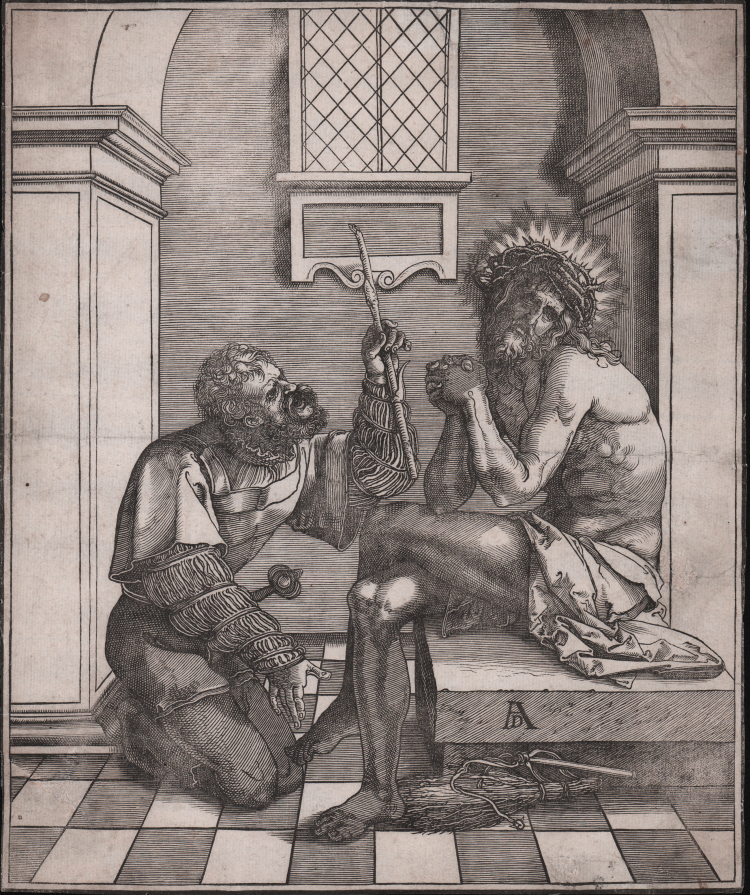- New




| Riferimento: | S50256 |
| Autore | Anonimo |
| Anno: | 1550 ca. |
| Misure: | 220 x 265 mm |



| Riferimento: | S50256 |
| Autore | Anonimo |
| Anno: | 1550 ca. |
| Misure: | 220 x 265 mm |
Anonima derivazione cinquecentesca del frontespizio della Grande Passione di Albrecht Durer, raffigurante Cristo - come uomo dei dolori – e un soldato che gli offre un ramo d’albero. A differenza della composizione originale questa scena si svolge all’interno di quella che sembra essere una prigione.
La stampa è molto rara e potrebbe anche essere una derivazione italiana. Un esemplare è conservato al Louvre.
https://collections.louvre.fr/ark:/53355/cl020579935
'Dürer made seven of the twelve woodcuts of his Large Passion series between 1497 and 1500, and then produced four additional woodcuts, the 'Last Supper', the 'Arrest of Christ', the 'Descent into Limbo' and the 'Resurrection' much later in 1510. In the following year, he published the series in book form with Latin verses composed by Benedict Schwalbe and a title-page design, 'Christ as the Man of Sorrows', at the same time as a second edition of the Apocalypse and the first edition of his Life of the Virgin series. There are a number of references to these three works, "die grossen Bücher" in Dürer 's diary of his journey to the Netherlands in 1520-21 which indicate that he often, but not always disposed of them together. On one occasion, he exchanged the three for a publication by Martin Luther.
This complete book is open at the title-page for the Large Passion. Dürer sold impressions of these prints separately for many years before the book edition and eleven such early impressions, which are distinguished by having no text on the versos, following the sequence in which they appear in the book. The difference in Dürer's style and technical achievement between the early prints of the series and those made some ten years later, clearly illustrates the level of his accomplishment. This distinction was even commented on by Giorgio Vasari, who interestingly assumed that the earlier woodcuts, which he considered deeply inferior despite possessing Dürer's monogram, were executed after Dürer's death "for the sake of gain, by other people who were unscrupulous enough to assign them to Albrecht" (see Vasari, V, p.5). (cf. G. Batrum, Albrecht Dürer and his Legacy, BM exh.cat., 2002, no.118a).
As in "The Small Passion" Dürer chose Christ, as Man of Sorrows, for the frontispiece of "The Large Passion" when he issued it in book form in 1511. A Latin text compiled by Benedictus Chelidonius accompanied the illustrations which had been prepared intermittently during the preceding decade.
Much like the builders of the great cathedrals of Christendom, who made periodic additions to their edifices, Dürer was seemingly not perturbed by the inconsistency of style in the leaves of "The Large Passion". However, the frontispiece he chose functions as a unifying factor that emphasizes the spirit in which they were conceived. For the scene pictured is not an occurrence of Christ's Passion, not a "Mocking of Christ" as it would seem at first glance. The fringe of clouds places it in the realm of imagination, and the Saviour's wounds denote that Christ is here pictured after the crucifixion. Thus it is, in fact, a reference to the then widely held belief in the "Perpetual Passion" of Christ, who continues to suffer for man's new sins. Chelidonius's verses beneath the woodcut make this abundantly clear:
"O Man, these cruel wounds I bear for thee to cure thy mortal illness with my blood, and see, thy sores, thy death I take on me A God transformed to man for thee. But still thy sins ungratefully stab me without heed thou maketh me suffer for each guilty deed. From hostile Jews I learned to suffer once, shall it not cease? Let suffering end, once is enough, now friend have peace"!
And this explains why in the woodcut Christ, crowned with thorns, as he sits on the cold stone, the scourge on the ground next to him, looks at the beholder, pleading for an end to sin. The armed man has been deemed to represent the soldier who had sneeringly offered Christ a branch for a scepter-cut from the tree that had grown from the sapling that Seth had taken from the Tree of Life and placed on Adam's grave. According to legend, the Cross had been made from its wood. This renewed offering of a greening branch would therefore make reference to "The Perpetual Passion."
In our view, the figure on the left may, however, represent not a soldier, but man, whose gesture implies a plea to the Saviour to accept this rod, cut from live wood, to use for keeping man within bounds. But Christ cannot accept it, as his hands are symbolically joined, for his rod is love. In contrast to "The Small Passion" for which Chelidonius composed the verses, he compiled the text for "The Large Passion" from several sources: Jerome of Padua's, Carmen de Jesu, Domenico Mancino's Passio domini nostri Jesu Christi, portions from the writings of Baptista Mantuanus for which Sebastian Brandt had written a commentary, and Vaelius Sedulius Paschale carmen. (cf. W. L. Strauss The Woodcuts and Woodblocks of Albrecht Durer, p. 453).
Bellissima prova, impressa su carta vergata coeva priva di filigrana, minimi restauri al lato destro, per il resto in ottimo stato di conservazione.
Bibliografia
Heller, 1927, n. 1112; TIB 1981 (commentary), n. 204/C2.
Cfr. Meder 1932 / Dürer Katalog (n. 113, II, c/f); Bartsch / Le Peintre graveur (VII.117.4); Schoch 2001-04 / Albrecht Dürer, das druckgraphische Werk. 3 vols I Intaglio, II Woodcuts, III Book illustrations (II.154); Strauss, The Woodcuts and Woodblocks of Albrecht Durer, pp. 453-455, n. 157.
Anonimo
Anonimo